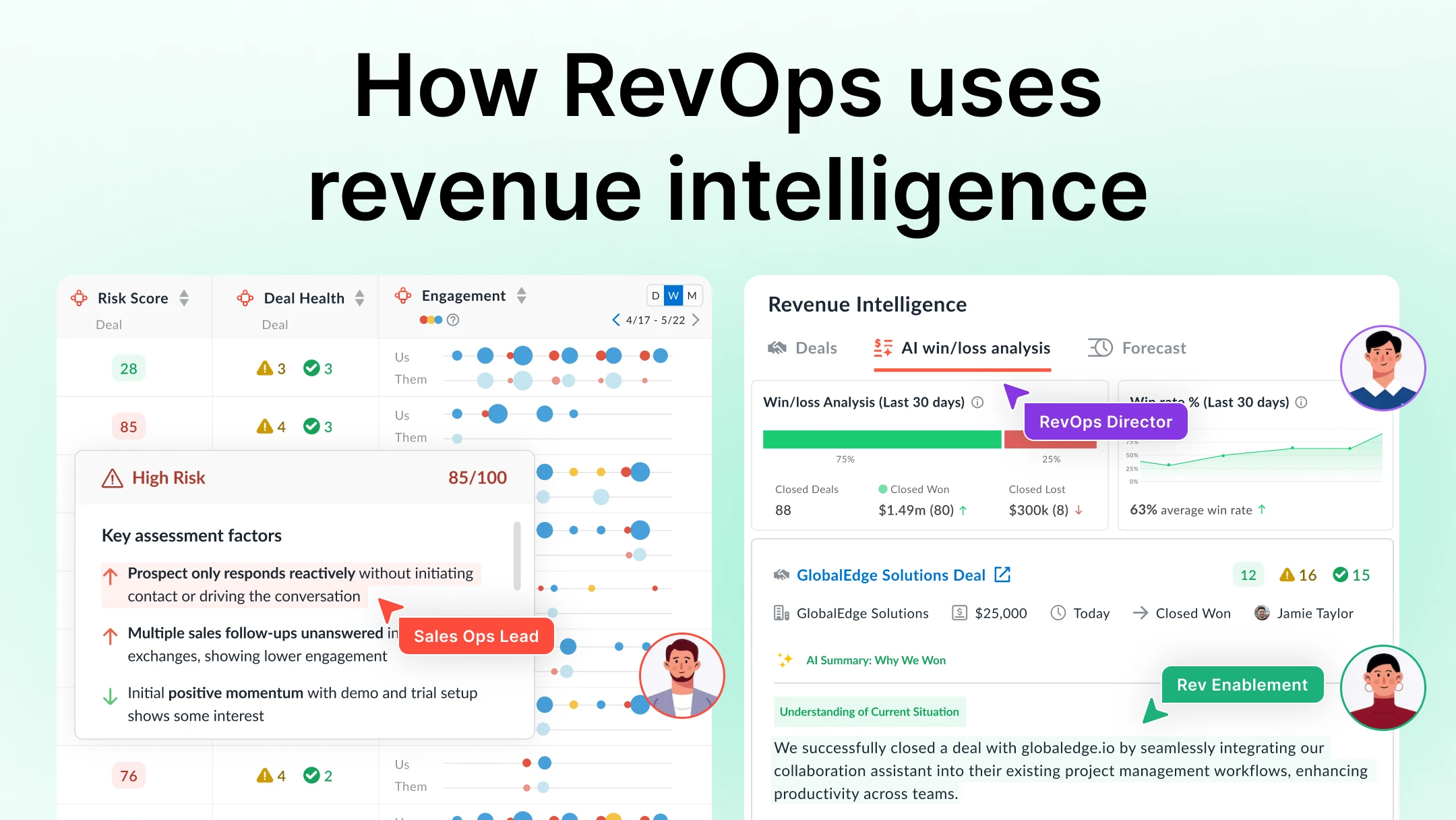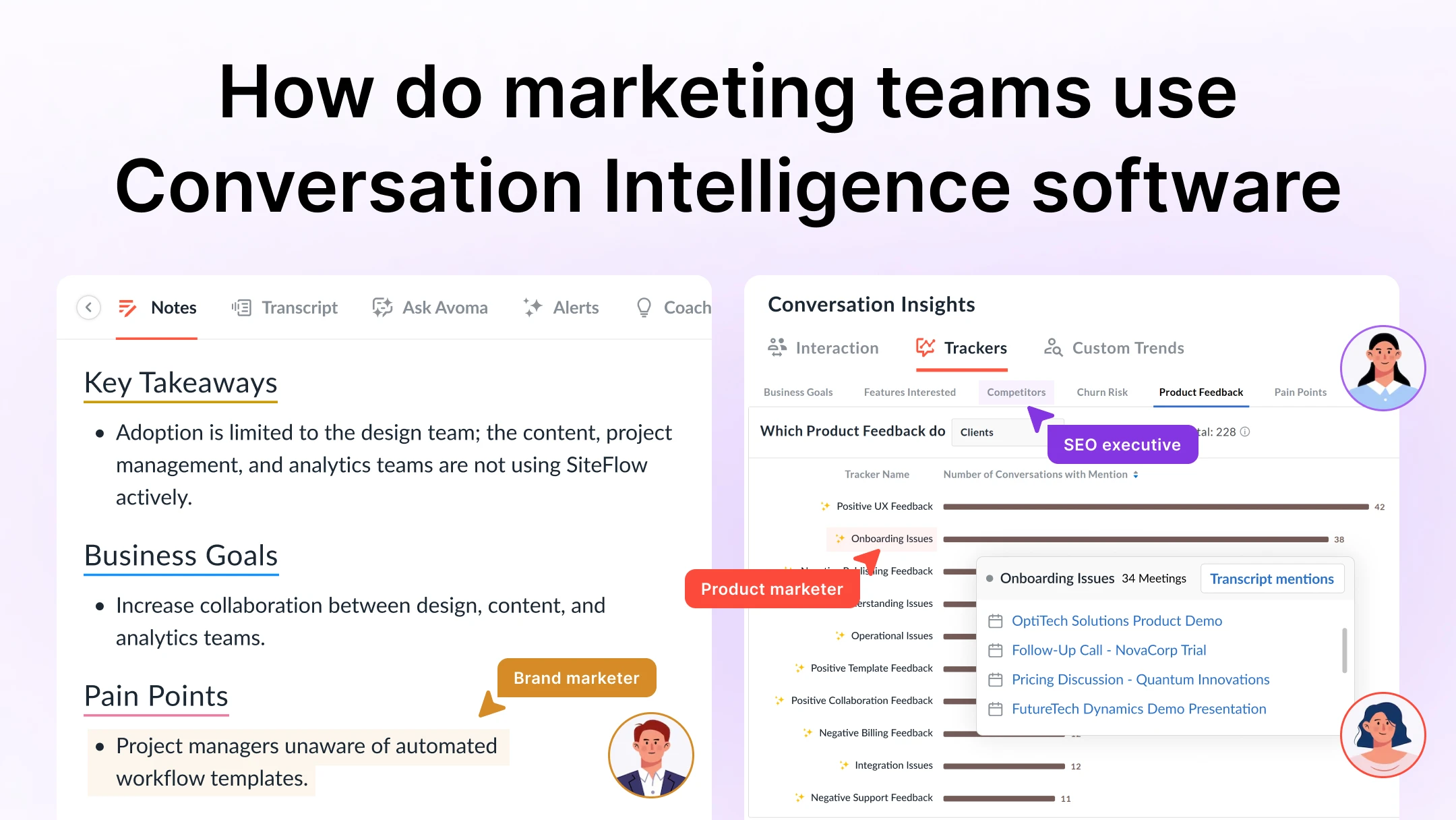Sandler Sales Methodology: How AI drives team adoption and performance
Table of Contents:

Thinking about using the Sandler as a sales methodology for your team? Whether you're just learning about it, already familiar, or need help putting it into action, this guide is here to help.
We’ll cover the following:
What is the Sandler sales style?
The Sandler Sales Methodology was introduced by David Sandler in 1967. It revolutionized the sales process by shifting focus from aggressive selling to consultative selling.
The method focuses on understanding needs and building long-lasting client relationships. This approach has been known to increase win rates. Sandler claims that salespeople using this method are 50% more likely to hit their quotas, and 88% say their sales strategy improved. Plus, it helps sales reps create loyal clients, leading to higher lifetime value (LTV) for the business.
The three core stages of Sandler Selling

- Building relationships: The foundation of any successful sale is trust. In this stage, sales professionals engage in open dialogue with prospects to build rapport. They demonstrate genuine interest through active listening and insightful questioning.
- Qualifying opportunities: Not every prospect is a good fit. This stage involves digging deep into potential client's pain points. The goal is to determine if they genuinely need your solution. By qualifying leads early on, sales teams can focus their efforts on those most likely to convert.
- Closing the sale: Once trust is built and the opportunity is clear, closing the sale becomes a smooth next step. Rather than using high-pressure tactics, salespeople show how their product solves the prospect’s specific problems.
7 steps of the Sandler process

The 7 steps of the Sandler process guide sales teams through a structured, no-pressure approach. Here’s how it flows:
- Bonding and rapport: Build mutual trust by genuinely connecting with the prospect. People buy from those they trust — no shortcuts here.
- Up-front contracts: Set clear expectations upfront for each interaction. Who doesn’t appreciate knowing what’s next?
- Pain discovery: Ask the tough questions to uncover the real challenges. Without pain, there’s no sale. Here layered questioning helps uncover emotional and practical impacts of a prospect’s challenges. This helps bridge the gap between the general concept of pain discovery and sales tactics. We will see in detail the Sandler Pain Funnel later in the article.
- Budget: Discuss budget considerations early. If the budget doesn’t align, it’s a waste of time.
- Decision-making process: Who decides, how, and when? Get clarity on the key decision makers before you move forward.
- Fulfillment phase: Present your solution only if the fit is right. Solve, don’t sell.
- Post-sell phase: Reinforce the commitment and prevent buyer’s remorse. No last-minute surprises.
Each step keeps you in control and ensures mutual commitment. If done right, by the end, your rep should feel confident, and the buyer should see it as a no-brainer. Isn’t that the goal of every sale?
Understanding the sandler pain funnel
The pain funnel is a series of questions that starts broad and gradually narrows down to the specifics. You begin by asking general questions about your prospect’s challenges. Then, you follow up with more pointed questions that dig into the effects these challenges have on their day-to-day work and even their personal goals. It helps you reveal not just the surface issues, but also the deeper, personal impact of these challenges.
How does the Pain Funnel work?
You can think of the pain funnel as a conversation guide that helps you get to the heart of a problem. Here’s a quick breakdown:
- Start broad: Ask something like, “What challenges are you facing in your operations?” This opens the conversation.
- Dig deeper: Follow up with questions such as, “How has this issue affected your team’s productivity?” or “What steps have you already tried?” These questions help you see the real impact.
- Explore consequences: Ask, “What happens if this problem continues?” or “How does it affect your personal goals?” This reveals the urgency behind the issue.
- Clarify the need for change: Finally, ask, “What would solving this problem mean for you?” This helps both you and the prospect understand the benefits of a solution.
Real-world examples
Imagine you’re on a call and your prospect mentions that project delays are a common issue. Instead of stopping there, you might ask:
- “How do these delays affect your team’s workflow?”
- “What impact does this have on your client relationships?”
- “If you could fix these delays, how would your daily operations change?”
These questions give you a clearer picture of the challenges and help the prospect realize the costs of inaction.
Why the pain funnel matters
The pain funnel does more than just gather information. It builds a connection between you and the prospect. When you ask thoughtful questions, you show genuine interest in their problems. This approach positions you as a partner who understands their needs, rather than just another salesperson.
By using the pain funnel, you help prospects see the benefits of addressing their issues now rather than later. This method can lead to faster decision-making and a smoother sales process.
Integrating the Sandler pain funnel into your conversations is a practical way to create meaningful dialogue. It not only strengthens your relationship with prospects but also sets the stage for a solution that truly fits their needs.
Using this approach in your sales calls can make all the difference. It turns a simple conversation into a chance to uncover real challenges and build a foundation of trust. Give it a try next time you’re on a call, and notice how it can open up deeper, more productive discussions.
Sandler vs Challenger: What's the difference?
People often wonder how the Sandler method differs from the Challenger sales method. Here’s a quick breakdown:
The Challenger method focuses on challenging a prospect’s assumptions, offering insights, and guiding the conversation through a teach-tailor-take-control approach.
In contrast, the Sandler method emphasizes the mutual qualification process and relationship-building. It treats sales as a collaborative dialogue where both sides determine fit early in the process.
How Generative AI can increase the close rate with Sandler selling
Sandler system focuses on building relationships with prospects and every step matters. But let’s be real, holding your team accountable to actually follow the Sandler Sales Process is easier said than done.
That’s where generative AI steps in. It helps your team be consistent and make sure no steps are skipped. Plus, AI can provide insights into how Sandler helps improve your reps' performance over time.
AI can also help with rep’s day-to-day busy work so they can solely focus on building rapport and trust with the buyer to move the deal forward.
1. Automated AI notes & email follow-ups: Reps can focus on truly listening during the meeting instead of worrying about taking notes or crafting follow-up emails. This helps them engage more personally and make the buyer feel heard.

2. AI-powered Scorecards based on Sandler: Every call gets scored by AI using the Sandler framework. If something’s missed, like not discussing pain points or asking about the decision process, it gets flagged in real-time. It’s easy to overlook a few steps, but this ensures reps stay on track and consistent. AI will go through every interaction to determine how well each step was executed with a clear justification behind it.

3. Performance dashboards: Track how your reps are improving over time. Are they missing key questions or not diving deep enough into certain topics? You can use this info to create focused coaching programs that address these areas for growth.
4. Automated CRM entry: Another time-consuming post-call routine for sales reps is entering details into CRM. AI tools can automatically log key details into your CRM, capturing each client’s specific needs and preferences. You can focus on the conversation while AI ensures your data is accurately tracked and synced.
Avoma's AI auto-detects topics discussed during the meeting and syncs in CRM properties for you. The deal-level details are synced in both directions, and you always have updated information in Avoma and your CRM.
The Sandler Scorecard: Perfecting discovery calls with Avoma
Many sales leaders see the value of the Sandler system. But getting their teams to follow it consistently is a struggle. Even with solid training, sales reps often miss key questions during calls. They don’t have a real-time guide to help them stay within the Sandler process. It’s like driving without a dashboard. It’s easy to lose track of what matters.
Leaders struggle to track if the process is being followed or where coaching is needed. Without a clear understanding, it’s difficult to know how to help their team improve.
Reps often don’t receive feedback on their calls, which makes progress slow and uncertain. Without clarity, refining their approach becomes a guessing game.
How Avoma helps with the Sandler Scorecard
Avoma's AI actively assists your reps during calls and provides automated scoring after the call for Sandler implementation.
- Real-time guidance during meetings: During calls, reps can use a meeting template with smart categories and prompts to stay aligned with the Sandler framework.
- Automated AI scoring: Avoma’s AI-powered Sandler scorecard automatically grades calls based on the 7 step framework. This saves you time by eliminating the need to review every call manually. The AI scoring follows a 5-point scale, with 5 (Green) as the best and 1 (Red) as the worst.
.

- Customization: If you need to update a completed Sandler scorecard, you can easily make changes. Whether it's a small fix or a major update, you have full control. This ensures your scorecard stays accurate and aligned with your needs.
Avoma helps sales teams analyze their conversations using the Sandler Scorecard to score each stage of the sales process. By using AI to evaluate key elements of the Sandler Selling System, Avoma identifies strengths and areas for improvement. Like having a mentor review the calls, it spots what the reps are doing well and where they can level up. This helps teams execute better, stay consistent, and close more deals.

The criteria Avoma uses to score each stage of the Sandler system
1. Establish bonding & rapport
Question: How well did the rep establish a personal connection and build trust?
Scoring Options:
- No effort to build rapport; the conversation lacked trust or connection.
- Minimal engagement; interaction felt surface-level.
- Some rapport established; comfortable but not deeply connected.
- Friendly, engaging conversation with mutual trust and respect.
- Strong connection; open and honest communication fostering engagement.

2. Set up an up-front contract
Question: Did the rep clearly define roles, expectations, and objectives for the conversation?
Scoring Options:
- No objectives or expectations discussed.
- Objectives partially defined but unclear on next steps.
- Objectives defined, but expectations and next steps remain vague.
- Clear objectives, some discussion of next steps, but not fully aligned.
- Well-defined objectives, expectations, and next steps, with quantifiable metrics.
3. Identify the prospect’s pain
Question: How effectively did the rep uncover the prospect’s problems and their impact?
Scoring Options:
- Pain points not discussed.
- Partial understanding of pain points, lacking depth.
- Surface-level pain points identified, but no deeper probing.
- Pain points and some impacts discussed, but metrics are unclear.
- Pain points, causes, and measurable impacts fully explored and quantified.
4. Uncover the prospect’s budget
Question: Did the rep explore the prospect’s investment capacity in terms of time, money, and resources?
Scoring Options:
- No discussion of investment criteria.
- Brief mention of criteria but lacking clarity.
- Budget discussed, but no mention of time or resources.
- Budget and one other factor (time/resources) discussed but incomplete.
- Clear and detailed discussion of budget, time, and resource commitments.
5. Identify the decision process
Question: Did the rep thoroughly understand the prospect’s decision-making process, including stakeholders and timelines?
Scoring Options:
- No discussion of decision-making process.
- Partial discussion; key elements missing or unclear.
- Basic details (decision-makers and timeline) covered, but lacked depth.
- Decision-makers and timelines discussed, but decision criteria unclear.
- Comprehensive understanding of decision-makers, timelines, criteria, and rationale.
6. Present a tailored solution
Question: Did the rep propose a solution aligned with the prospect’s needs, budget, and decision-making process?
Scoring Options:
- Generic solution misaligned with the prospect’s needs.
- Partially aligned solution; gaps in budget or process fit.
- Relevant solution fitting needs and budget but not decision process.
- Mostly aligned solution; minor gaps in addressing the process.
- Comprehensive solution perfectly addressing needs, budget, and process.
7. Confirm post-sell process
Question: Did the rep establish clear next steps and expectations for future engagement?
Scoring Options:
- No next steps or follow-up scheduled.
- Basic next steps discussed but lacking clarity or follow-up.
- Follow-up scheduled with clear next steps, but no additional stakeholders involved.
- Follow-up scheduled with additional stakeholders and action items partially defined.
- Clear follow-up, next steps, and action items defined, involving multiple stakeholders.
By using this structured scorecard, sales teams can objectively assess discovery calls, identify areas for improvement, and ensure alignment with the Sandler Selling System principles.
Conclusion
We hope this article helped you understand the Sandler Sales Methodology and how it can improve your sales approach. If you feel inspired, give it a try!
Already know the Sandler method and want to use it more easily? Avoma’s AI Scorecards can help. They let you track your team’s performance and make steady improvements.
Want to learn more? Connect with our product specialists. They’ll show you how Avoma’s Sandler Scorecards can help your team win more deals. Let’s make your sales process easier and more effective!
Frequently Asked Questions






What's stopping you from turning every conversation into actionable insights?









